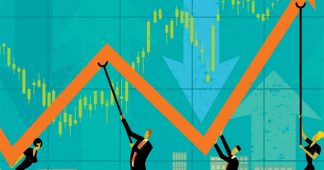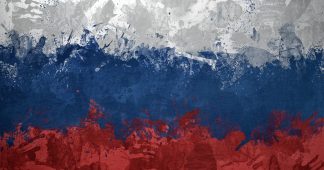by Oct 1, 2022
A Brief Overview of Soviet Planning History
The successes achieved by the USSR thanks to the socialist revolution of 1917—which transformed a backward, agrarian country, rich in raw materials and possessing a huge foreign debt, into an advanced scientific and technological power that determined a bipolar world—are overwhelming. However, after the counter-revolution of 1991, Russia returned to its past. It has again become a raw-material appendage of the world capitalist community and continues to slide downward.
Depending on the emerging conditions and the accumulation of experience in planning the economy, the model of the socialist economy in the USSR changed. In its construction the following periods can be distinguished: war communism, the New Economic Policy, the course of industrialization, and the dismantling of economic planning.
War Communism (1918–1921)
The Great October Socialist Revolution of 1917 established the power of the Soviets of Workers’, Soldiers’ and Peasants’ Deputies in Russia by March 1918. The Soviet state developed the first balances characterizing resources (initially, primarily foodstuffs) and their use for the survival of the people. In its troubled, chaotic early years—there was both a civil war and a war against the intervention of many Entente countries—Soviet Russia, under the leadership of V. I. Lenin, managed to maintain power in the country, not allowing it to collapse into pieces. While solving the difficult task of retaining power, Lenin was advancing his idea of progress: the electrification of the whole country.
Under Lenin, the state introduced a monopoly on foreign trade and foreign currency transactions; nationalized land, industrial enterprises, transport, and banks; banned the private trade of essential products; introduced general labor conscription; and advanced workers’ control over the production and distribution of vital products. The Supreme Council of the National Economy was responsible for coordinating the activities of enterprises to implement quarterly, and then later, annual plans.1
In 1920, the government established the State Commission for the Electrification of Russia (GOELRO). It considered electrification a “powerful factor” in the growth of labor productivity. GOELRO was based on an analysis of social needs, balancing them with available resources and with reference to territorial development plans. It was intended to restore the economy to pre-war levels in ten to fifteen years. In 1921, for its implementation, the State Planning Committee (GOSPLAN) was created to develop and implement a national economic plan based on the electrification project.2
GOELRO was faced with complications. Information about the current state of the economy and knowledge of economic planning was not enough. The construction of power plants required the supply of machines, tools, and raw materials, which, in turn, had to be produced. For this production to take place, material support was needed. It was also necessary to consider the interconnections of the manufacturers involved in the implementation of the GOELRO goals. However, this understanding of planning occurred later. The absence in the early stages of planned calculations of all production relationships for supporting the goals of GOELRO led to a halt in the construction that had begun, including closures of factories supplying essential products, in turn leading to an economic crisis. Scheduling errors resulted in increased imbalances, production shutdowns, and plant closures. The country was thus forced to switch to the New Economic Policy.
New Economic Policy (1921–1927)
The New Economic Policy, based on a mixed economy with different forms of ownership while preserving the state-directed economy, was a step backward. But it was necessary to construct a practical form of socialism that understood the importance of various forms of property since the Soviet state, still in its infancy, was not able to manage everything effectively.
The principle of “party maximum” was introduced in June 1921 for party members who were executive employees of institutions and enterprises. The idea came from the Paris Commune of 1871. According to this principle, salaries of executive employees would not exceed 150 percent of the average salary in the enterprises under their control.3
The goal of the New Economic Policy was to restore the national economy by maintaining control over heavy industry, transport, banks, and wholesale and international trade, while introducing private entrepreneurship and raising foreign capital. State-owned enterprises competed against each other. Agriculture, retail trade, services, and light industries were mostly in private hands.
GOSPLAN began to develop balances in order to provide producers with the preconditions of food and livestock, as well as the necessary means to make rubber, metal, and other materials. The 1924 balances developed by the GOSPLAN were compiled into a single table—the balance of the national economy, covering the most critical product flows. In the introduction to this work in which this table appears, P. Popov wrote that “neither in the statistical, nor in the economic literature, nor in the Russian, nor in the Western European literature, were there any examples of such works, and we had to decide on our own in the process of forming not only the technical method of research, but also the methodological prerequisites.”4
The method known as “input-output analysis,” developed in the United States in the 1930s by Wassily Leontief, originally used linear algebra to build an economic and mathematical model and analyze the structure of the U.S. economy.
Joseph Stalin criticized this approach, calling it “a game of numbers.”5 Some argue that Stalin’s negative reaction to this work was because the balance contradicted the policy of forced industrialization, which broke the existing proportions of the economy—but in fact, the reason was quite different. Stalin, as the manager of the development of a huge country, was interested in algorithms for solving strategic problems, rather than simply describing them.
In 1926, the national economy was restored to 1913 levels, but economic growth began to slow and unemployment increased. The so-called “price scissors” between high prices for industrial products and low prices for agricultural products had caused rural areas to cease trade with cities, resulting in urban famines. Faced with growing economic problems by 1926, the Bolsheviks began to discuss a planning model capable of ensuring a high rate of industrialization.6
Those on the right, such as N. Bukharin, V. Bazarov, and N. Kondratyev, believed that the market would decide, and the state should only intervene to correct negative consequences predicted by the models. Leftists, including G. Krzhizhanovsky, V. Kuibyshev, and S. Strumilin, opposed this position, preferring a managed economy to ensure that the country could rapidly progress toward industrialization.7 This group proposed implementing successive approximations (iterations) in order to coordinate government orders with production capabilities. This was the idea of cybernetic planning of the economy, relying on feedback from manufacturers and adjustments to government orders depending on the capabilities of manufacturers.
The Course of Industrialization, the War Economy, and Economic Recovery (1928–1950)
The USSR made the transition from the New Economic Policy to the path of industrialization at the end of the 1920s. The intended plan was directed at the long-term planning of the economy by coordinating the input-output calculations at all levels of the management hierarchy through iterations. Investments became a managing parameter of the plan.
The starting points for planning were government orders to prioritize the development of key industries and the planned fund for public working time. Materials, labor, and financial resources were calculated by modeling the necessary production chains for determining capital investments to create additional manufacturing capacities. After all intra-sectoral calculations were carried out, applications for the material, labor, and financial resources were supplied to the top coordinating body: GOSPLAN. Taking into consideration the real capabilities of manufacturers, assignments for state orders were corrected, and a new round of calculations began. The process continued until a balanced input-output plan was obtained within the specified calculable accuracy. Only after that were contracts concluded and the plan turned into a directive. The principle of rolling planning enabled the government to make timely adjustments to the plan.
Between 1929 and 1934, the USSR was first in Europe and second in the world in terms of growth of industrial production and national income.8
The advantages of this method were demonstrated by the centralized economy of the USSR during the Second World War. Quarterly, monthly, and ten-day recalculations became the main form of planning. For example, while smelting about three times less steel and producing almost five times less coal than Germany, the USSR created almost twice as many weapons and military equipment during wartime.9
After the war, the course of industrializing the Soviet economy continued. Every year between 1947 and 1954 saw real incomes of the population increase, rising by up to 34 percent compared to pre-war levels.
Competition between the United States and the USSR began in the Cold War. The U.S. strategy was to export investments to other capitalist countries, with the construction of a unipolar world of dollar-based hegemony regulated by the International Monetary Fund. Meanwhile the USSR maintained its course of industrialization regulated by economic planning of key industries.
In the “clash” of the superpowers, there were unequal starting conditions. During the war, U.S. industry had doubled, and by 1945, U.S. gold reserves accounted for more than 70 percent of the world’s reserves overall.10 The main achievement of the United States was the development of the science of cybernetics, which studied information processes to create automated control systems. After the economic recovery in the post-Second World War years, the USSR’s leadership should have seen the importance of cybernetics in the development of economic planning. Instead, this new science was incorrectly described as a pseudoscience, slowing down its development in the USSR.
The Collapse of the Project of the Socialist Economy of the USSR (1950–1991)
Achieving military parity with the United States was not enough to enable the USSR to win the Cold War. The continuation of the course of industrialization after the war led to a disproportionate development of the economy, resulting in an economic crisis. The USSR needed to transition from prioritizing the development of industries that determine technological progress to improving its citizens’ quality of life.
By the 1950s, the economy of the USSR was faced with the problem of processing a colossal amount of information for planning the national economy. The volume of production increased and relationships between producers became more complex, requiring many iterations to generate plans. This was not possible with manual planning. It required the automating of state management of the economy and developing small businesses in industries directly related to satisfying domestic needs.
Disregard for cybernetics drew the country into discussions about the economic problems of socialism, which continued after Stalin’s death and were followed by the imposition of a damaging theory of commodity production under socialism, serving to deform the economy of the USSR by initiating economic chaos and eventually restoring capitalism in 1991.
The complex, planned control of a huge country required automation. After discussions that took place from 1956 to 1957 at the Institute of Economics in Moscow under the leadership of academician K. Ostrovityanov, a troubled mode of commodity production under socialism was officially adopted, contradicting Karl Marx’s writings on the practice of economic planning. State-owned enterprises worked according to the plan and, at the same time, for profit. This doctrine divided the country’s economists into Marxists (advocates of a non-commodity economy), who denied the commodity nature of production under socialism, and restorers of capitalism (promoters of a commodity economy). The ideological struggle between these economists received a new impetus with the awareness that cybernetics were needed to solve economic problems.
Yet, while cyberneticists were busy solving the complex problem of automating economic management, the party nomenklatura, afraid of losing the privileges that came from planned, manual control, imposed economic “reforms” from the 1950s through the ’90s. At the same time, a shortage of goods in the consumer market was created in the short-term interests of the nomenklatura by fixing prices, which led to increased speculation and corruption. The system of equilibrium prices—a necessary feedback mechanism of the consumer market that plays an important role in optimizing the supply structure—was excluded from the economic planning process. This doomed the ruble to defeat by the dollar. The reforms aimed at giving more and more rights to enterprises, allowing them to focus on profit, intensified the chaos in public administration and ultimately led to the collapse of the country in 1991, with the restoration of capitalism and the transfer of management of the country’s development to global capitalist forces.11
How do we explain why the nomenklatura ended up choosing to dismantle socialism? It is necessary to note that Stalin eliminated the party maximum in 1932. According to the academic E. S. Varga, the abolition of the party maximum contributed to the disintegration of Soviet society into layers with huge differences in income and the personal enrichment of appointed party nomenklatura. Their example was followed by the bureaucracy and the lower strata, becoming expressed in careerism, intrigues against competitors, theft, and corruption. The contradiction between the officially proclaimed communist morality and the real ideology of the ruling circles led to a widening gap between the elites and the working people, and encouraged cynicism and careerism in society.12
The steady transformation of a workers’ state into a bureaucratic state by Stalin’s abolition of the party maximum was not a linear process. There was an ideological struggle by those who, despite the creeping restoration of capitalism, continued to work for the practical implementation of communist ideals. During the Great Patriotic War (the Second World War), there is no doubt that Stalin and party authorities fully reflected the aspirations of the masses. It is an undeniable, historic truth that Soviet leadership under Stalin—though at a huge human cost—made an enormous contribution to the creation of the world’s first socialist economy, which managed to defeat fascism and become one of the centers of the bipolar world. In this period, the USSR carried through its first planned industrialization program, which both secured victory in the Second World War and further enabled the post-war economic recovery.
Digital Projects of Capitalist and Socialist Economies
Digital Projects of the Capitalist Economy
The current economic crisis, ongoing since 2008 and most recently punctuated by the pandemic slowdown, constitutes the deepest downturn of the post-war period. Unprecedented progress is predicted in both cybernetics and artificial intelligence (AI). However, the introduction of digital technologies into the fields of trade, financial services, workflow, and population control, all happening in the context of economic chaos, reduces social productivity and destroys society while increasing the power of multinational corporations.
The material carrier of AI is a computer or a computing network that provides data exchange to serve users. The interests of the dominant social strata determine the functions of AI and algorithms. Multinational corporations, striving to preserve capitalism and keep power, resorting to speculative instruments such as “green” derivatives and cryptocurrencies, set a course of “peaceful” creative destruction of production and significantly increased the relative surplus population through the introduction of AI. They have used the pandemic period to rapidly develop AI that controls the behavior of people and to establish a so-called Green Course aimed at “liberating” the planet from real human needs.
All current and conceived global projects emanating from multinational corporations and the United States, such as “inclusive capitalism” and the Green New Deal, lack viable strategies for overcoming the global crisis and therefore are aimed simply at preserving capitalism.13
There are naive ideas about the possibility of achieving economic planning using algorithm-based digital platforms that centralize and manage information without the influence of corrupt interests. A 2017 article by John Thornhill notes the possibility of using state digital platforms for planning production. It quotes Jack Ma, founder of Alibaba, who asserts that “Big Data” will make the market smarter and eventually build a planned economy.14
But so-called big data is actually a spontaneous set of indicators that will never solve the problem of disproportionate economic development. Without eliminating the causes of the global crisis, the expansion of big data only increases the exploitation of personnel and information chaos, leading to a robotic society with massive unemployment and total control over its populations through AI.15 In his conceptualization of the fourth industrial revolution and the new trans-humanistic order, Klaus Schwab replaces democracy with the dictatorship of multinational corporations, seeking to use the achievements of the digital revolution to establish complete digital control over humanity.16
The situation today confirms the words of the great cyberneticist Norbert Wiener: “Let us imagine that the second [industrial] revolution is over. Then the average person with average or even less ability will not be able to offer anything for sale that would be worth paying money for. There is only one way out—to build a society based on human values different from buying and selling. To build such a society will require a lot of preparation and a lot of struggles, which, under favorable circumstances, can be conducted on the ideological plane, and otherwise—who knows how?”17
Schwab’s ideology relies on the paradigm of economic cybernetics. This same paradigm underlies the creation of an automated management system for a socialist economy in the interests of people. This science was born in the USSR—the only country with a history of dedicated attempts to use computing power to improve the quality of life for the people, and not just the profits of a minority segment of society.
Digital Projects of the Socialist Economy
Wiener’s Cybernetics was published in the USSR in 1958, a decade after it was first written. In the same year, the Laboratory of Economics and Mathematical Methods in Moscow (later, the Central Economics and Mathematics Institute [CEMI]) and the Institute of Economics and Industrial Organization in Novosibirsk were created under the guidance of scientist-statistician V. Nemchinov. The inspiration for these two institutions was Leontief’s input-output econometric model, which was based on the use of statistics and mathematics. It was designed to forecast scenarios, which had little to do with direct planning of the economy.18
Another technocratic method of creating an automated control system, ignoring the laws of economic development, was the basis for developing the National Automated System Management at the Institute of Cybernetics in Kiev. The Institute, founded in 1962 under the leadership of V. Glushkov, assumed that the national automated control systems would include a state computer network connecting data collection centers located in all regions of the country, and serve as the basis for the transition to optimal planning.
Glushkov and the head of the CEMI, N. Fedorenko, wrote a remarkable article in 1964 about the obstacles for nationwide integration of computing technologies into the economy of the USSR. They stated that whether or not an automated control system would be created for the economy would decide the fate of the country and its victory in the Cold War. This article put forward the goal of rigorously coordinating mutual efforts to create the nationwide automated control system, and sketched out the huge potential advantages as compared to the U.S. system, where each business pursues its own private interests.19
This was also noted in the United States. In 1962, John Kennedy’s advisor wrote a secret memorandum that “the Soviet decision to bet on cybernetics” would give the USSR a significant advantage. If the United States continues to ignore cybernetics, the advisor concluded, “we will be finished.”20
In practice, however, in the USSR, the narrowly selfish interests of the given institution were placed above those of the state. This is still the situation today. Glushkov, having no idea of what the automated control system software should be, installed hardware that did not work. There were huge costs for the introduction of expensive computers throughout the country. For this reason, the Ministry of Finance stopped funding the costly project. Today, all the developers of the digital economy are repeating Glushkov’s mistake.
CEMI and the Institute of Novosibirsk began to focus on the study of Western economic and mathematical models. The system of optimal functioning of the economy created by CEMI was based on hierarchical mathematical models of direct and dual tasks of linear and nonlinear programming. These mathematical models and econometric modeling of inter-sectoral balance in the formal terms developed by Leontief had nothing in common with the planning practice of GOSPLAN, which was forced to continue using the method of manual iterative planning.
These three institutions, operating separately, were not able to develop a methodology and model for optimal planning rapidly enough because the narrow-minded interests of researchers were placed above the public interest. The lack of a scientific approach was reflected in the institutions’ competition for funding to develop mathematical models of the automated control system. This affected the activities of the Main Computing Center of GOSPLAN, which was created in 1959 for the automation of system-planned calculations.
In the absence of a dynamic model of inter-sectoral balance that would coordinate calculations for all industries and economic sectors to ensure development in the desired direction, there was no interaction between sectoral automated control systems and automation of system-planned calculations. The Main Computing Center united branch computing systems and turned them into a body for analytical support of the 1965 Kosygin reform. While GOSPLAN asked to speed up the development of the automation of system-planned calculations, the sectoral ministries demanded more powers.21
In the critical absence of a model of inter-sectoral balance, the automation of system-planned calculations was reduced to a set of analytical tables created for different departments of GOSPLAN and the automated document management system, Dokument. Its task was to track the process of drawing up a plan, but not to automate the actual planning calculations. Furthermore, the activity of the Main Computing Center was reduced to the unification of the networks of GOSPLAN, with the computer systems of republics, ministries, and departments interacting in real time. The disease of workflow automation—instead of the automation of calculations that ensure real income growth—is inherent today in all countries of the world. Today, this primitive approach characterizes the Analytical Center for the Government of Russia, who calls this process an E-Government project.22
If we return to the origins of the problem in the field of economic and mathematical modeling and automation of economic management, then we should recall the 1962 creation in Minsk of the Central Research Institute of Technical Management under the leadership of the scientist-cyberneticist, Nikolai Veduta. This institute introduced automated systems of economic management at a number of large machine-building plants. Veduta was a practitioner in the field of economic planning. But his main success was in the creation of the country’s first automated control system, resulting in a dynamic model of inter-sectoral balance. This model is a system of mathematical algorithms that describe the coordination process between the orders of end consumers (government, households, and exporters) and the capabilities of producers, including the procedure for adjusting initial assignments to achieve the proper input-output balance.23
In the course of calculations, according to the model, the structure of the final product is optimized to increase the real solvency of the national currency and effectiveness in the choice of new technological methods of production in order to maximize the rate of economic growth, through which the fulfillment of macro-economic proportions and employment are ensured. The result of these calculations is the construction of production chains and the distribution of investments between industries so as to enhance the trajectory of growth in quality of life. It can be argued that the dynamic model of inter-sectoral balance is the only digital technology in the world that is able to “construct” the future, ensuring the development of the economy in the direction of social progress that realizes human values.
The main differences between Veduta’s cybernetic model of inter-sectoral balance and Leontief’s econometric model are as follows:
- The method of building the model. Veduta’s economic cybernetics requires integrating the actions of objective economic laws when modeling inter-sectoral balance. Leontief’s econometric model is based simply on statistics and mathematics.
- In planning technology. When constructing a cybernetic inter-sectoral balance, the method of successive approximations for calculating a plan is used, and in doing so the principles of proportionality, production efficiency, and optimization of the consumption structure are implemented. This method ensures the convergence and stability of solutions. Leontief’s econometric model of inter-sectoral balance uses scenario forecasts calculated on the basis of systems of equations, with economic forecasting parameters obtained by methods of mathematical statistics. The resulting solutions are unstable.
- Investments as a managing or predictive parameter. Investments are the governing parameter of the plan in a cybernetic model of inter-sectoral balance. The allocation of investments is determined iteratively during the calculations of the plan. In econometrics, investments are a predictive parameter that does not interfere with the competing interests lobbying for state support.
- Collecting information. An economic robot (AI in the economy, or automated control systems for economic management) is based on a cybernetic model of inter-sectoral balance that organizes information flows about final consumer orders, consumer market equilibrium price dynamics, production relationships, new technological methods of production, foreign trade balances, the balance of capital investments and income and expenditures of the population, and the state budget in the rolling planning mode (online). The econometric model of inter-sectoral balance uses statistics after the fact (ex-post) from the national accounting system.
The scientist-philosopher V. Pikhorovich notes that Glushkov, unlike Veduta, had tremendous support from the country’s leadership and was constantly busy promoting his idea. At the same time, Veduta, although holding similarly important and authoritative posts, was a lone enthusiast in developing the principles of automation. However, he had a significant advantage over Glushkov: he was not only a professional cyberneticist, but also a serious and principled political economist. Neither, however, were ranked among leading Soviet economists.24
The time has come to unblock Veduta’s cyber-planning to create a socialist economy. Socialism is the only global cybernetic project that is presently capable of implementing a plan for social progress realizing human values. Automation of economic management means the coordination of the activities throughout all industries and sectors of the economy, as well as all technical AI, so as to improve the efficiency of management decisions.
Lenin once said that socialism is Soviet power plus the electrification of the whole country. Today, this slogan can be paraphrased as socialism is democracy plus automation of the country’s economic governance. The introduction of economic AI, which automates managerial work, is a necessary condition for the transition from capitalism to socialism without the possibility of the former’s restoration.
Ten Conclusions
(1) Since the sixteenth century, the economic policy of states has been characterized by the cyclical nature of “mercantilism, war, and liberalism.” In the twentieth century, with the growing power of multinational corporations, this was transformed into a cycle of “inflation, war, and financial stabilization.” When the dominance of these corporations was established, inflation, a world monetary system based on the use of key reserve currencies, and the world market for loan capital were added to the economic instruments of the sixteenth through nineteenth centuries. These financial instruments, using flows of fictitious capital, redistribute income and assets in favor of multinational corporations, increasing technological and social inequality in the world. After the collapse of the USSR in 1991, a unipolar system was established, plunging the world into a deeper crisis.
(2) Speculative games end with assertion of hegemonic power and preparations for a new military solution to the unfolding crisis. With the coming to power of U.S. President Donald Trump in 2017, the world entered another phase of pre-war mercantilism, manifested in a sharp increase in trade and sanctions wars—a new arms race. In consideration of the nuclear potential of developing countries, and trying to avoid direct military conflict, multinational corporations added the achievements of the digital revolution to their financial toolbox.
(3) The pandemic has revealed that multinational corporations seek to use the possibilities of the digital revolution to preserve capitalism by establishing total control over human behavior, bringing the end of human history closer.
(4) The only alternative to capitalism is socialism. The first attempt to organize a non-capitalist, proportionally developing economy in the direction of a prosperous future was made by the USSR. The historical analysis of the development of the economic policy of the USSR, from war communism to the New Economic Policy to the path of industrialization, shows how the country gradually accumulated a balanced experience in economic planning and moved to use an iterative method to draw up its economic plans. Its most important principles were incorporating feedback to coordinate planned calculations, input-output, and rolling planning (adjustment of planned calculations online). Thanks to this early cybernetic planning of the economy, the USSR won the Second World War and became a major power of the bipolar world, determining the vector of global development.
(5) Reasons for the defeat of the USSR in the Cold War:
- Objective and subjective difficulties in being the first country in the world to implement national economic planning through successive iterations and manually carrying out necessary transformations, from the goals of industrialization to the growth of real incomes of citizens.
- Stalin’s elimination of the party maximum, which contributed to the collapse of Soviet society into social strata with huge differences in income; the enrichment of the appointed party nomenklatura; the flourishing of cynicism and careerism; and corruption in society. He therefore gave rise to those who would destroy him, and then the USSR as a planned economy.
- The adoption of the theory of commodity production under socialism in 1956 as the official doctrine for economic reforms, which gave enterprises more and more independence in their profit orientation and contributed to the restoration of capitalism in the interests of the party nomenklatura.
- The leading role of economic cybernetics in developing the theory and practice of economic planning with an eye to the transition from manual to automated planning was underestimated in its potential to increase the efficiency of management decisions and ensure the growth of real incomes of citizens.
- Continuing along the same course of industrialization without effective planning meant disproportionate development, economic reform, intensifying economic chaos, and a shadow market due to the fixation of prices in the consumer market, leading the USSR into a deep economic crisis that ended with the collapse of the country in 1991.
(6) In the context of a pandemic, digital technologies have been added to financial instruments of multinational corporations in the field of trade and financial services, workflow, and the use of AI as an instrument to control people, rather than the management of the economy. Realizing the need to reduce the risks inherent to coordinating production relationships through international trade, Western experts place hope on so-called big data technology. This, in their opinion, will lead the world to use profit-driven economic planning with the help of algorithms and without the corruption that emerged in the USSR. Such ideas testify to the lack of understanding by Western experts of the essence of cybernetic planning in the USSR and the contradictions imposed by the profit and commodity system, and, therefore, the impossibility of creating algorithms that could service these goals and provide a way out of the global crisis.
(7) The key to finding a way out of the global crisis should be sought in the alternative experience of socialist economic planning in the USSR. Its improvement required the transition from a manual system to an automated system. To create an automated control system (or economic robot), knowledge of economic cybernetics as the science of information processes in social production must be used to develop algorithms for coordinating input-output calculations, that is, cybernetic planning.
(8) Both the USSR and the United States recognized that if the USSR had time to create an automated control system for the economy, then the world today would be moving toward a different, more prosperous future. Difficulties in developing a dynamic model of inter-sectoral balance and the narrowly selfish interests of the institutions responsible for the implementation of automated control systems led to a competition for funding for research unrelated to improved planning of a socialist economy.
(9) Thanks to the knowledge of Capital, Marx, and the Soviet experience in managing the economy at different levels, Nikolai Veduta developed a dynamic model of inter-sectoral balance. His model is the only digital technology in the world that constructs and directs the development of the economy toward a prosperous future.
(10) Today, the cybernetic approach to economic planning is blocked. At the same time, vast state funds are spent in the interest of digital monopolies that are leading the world into dark times. The moment has come to implement cybernetic economic planning that coordinates the activities of all industries and sectors toward a prosperous, sustainable future. Its implementation will mean a management revolution that will significantly increase the efficiency of state and global management. Just as the introduction of machines led to the first industrial revolution, thus affirming capitalism, so the introduction of the economic robot will generate a genuine second industrial revolution and establish socialism without the possibility of capitalist restoration.
Endnotes
- ↩ N. Veduta, Strategy and Economic Policy Governance (Moscow: Akademicheskiy proekt, 2003).
- ↩ Council of People’s Commissars, “Management of Sovnarkom,” Assembly of Legislation and Deployment of Laws for 1921, no. 106, Statement of the Governmental Commissariat (1944).
- ↩ “Stalinskoye nevraventsko (Stalinist Inequality),” 1917.com (blog) (2015).
- ↩ G. Eljmeev and V. G. Ovsjnnikov, Applied Sociology: Opinions of Theories (St. Petersburg, University of St. Petersburg), 35.
- ↩ Joseph Stalin, Works, vol. 12 (Moscow: Pravda, 1929).
- ↩ Stephen Cohen, Bukharin and the Bolshevik Revolution: A Political Biography, 1938–1988 (New York: Alfred A. Knopf, 1988).
- ↩ S. Autonomov, O. I. Ananin, and N. A. Makasheva, “Economic Discussions of the 1920s on the Nature of the Planned Economy” in The History of Economic Doctrines, ed. V. S. Autonomov (Moscow: INFRA-M, 2002).
- ↩ Raymond Barr, Political Economy (Moscow: International Relations, 1995).
- ↩ Veduta, Strategy and Economic Policy Governance.
- ↩ Veduta, Strategy and Economic Policy Governance.
- ↩ Poteryaiko, “Professor Veduta: There Is No ‘Digitalization’ That Can Help, If the Direction of Economic Policies Is Corrupt,” Svobodnaya Pressa (December 19, 2019).
- ↩ Politburo Central Committee, “Protocol No. 87 of the Sessions of the Politburo Central Committee VKP” (February 8, 1932): 9; “Stalinskoye nevraventsko (Stalinist Inequality).”
- ↩ N. Veduta, “Manifesto for Inclusive Capitalism: ‘Trust Us, and You Will Be Happy,” REGNUM News Agency, December 2, 2021; E. N. Veduta, “New ‘Green’ Course Called to End Our Economics,” Business Online, May 26, 2021.
- ↩ Veduta, “New ‘Green’ Course Called to End Our Economics”; John Thornhill, “The Big Data Revolution Can Revive the Planned Economy,” Financial Times, September 4, 2017.
- ↩ Guy Standing, The Precariat: The New Dangerous Class (New York: Bloomsbury Academic, 2011).
- ↩ Klaus Schwab and Thierry Malleret, COVID-19: The Great Reset (Zurich: Agentur Schweiz, 2020).
- ↩ Norbert Wiener, Cybernetics, or Control and Communication in the Animal and the Machine, (Cambridge, Mass.: MIT Press, 1948), 77.
- ↩ Wiener, Cybernetics.
- ↩ Glushkov and N. Fedorenko, “Problemy shirokogo vnedrenija vychislitel’noj tehniki v narodnoe hozjajstvo,” Voprosy jekonomiki (1964).
- ↩ Pikhorovich, Essays on the History of Cybernetics in the USSR (Moscow: Lenand, 2019).
- ↩ Safronov, “Pionery cifrovizacii Analiticheskij centr pri Pravitel’stve Rossijskoj Federacii” (2019).
- ↩ N. Veduta, S. Evtushenko, and Ju Haritonov, “Smogut li politiki upravljat’ jekonomikoj,” REGNUM News Agency, 2019.
- ↩ Veduta, Strategy and Economic Policy Governance.
- ↩ Pikhorovich, Essays on the History of Cybernetics in the USSR.
We remind our readers that publication of articles on our site does not mean that we agree with what is written. Our policy is to publish anything which we consider of interest, so as to assist our readers in forming their opinions. Sometimes we even publish articles with which we totally disagree, since we believe it is important for our readers to be informed on as wide a spectrum of views as possible.











